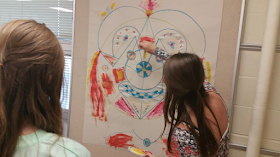The name of this blog is somewhat of a misnomer. "Transition to Choice-Based Art Education" can suggest a high degree of student autonomy with respect to learning experience. In the hands of a Teaching for Artistic Behavior practitioner, choice becomes the instrument from which learner-directed art experiences are realized where children control as many facets of the creative process as the setting will support. The student has a high degree of autonomy, may select from a variety of materials, work from selected studio centers and is the originator of the ideas expressed during the creation of the artwork.
 |
| Students begin a drawing game called "Copycat." |
 |
| Students turn their drawing structure into a clown face. |
 |
| Another student in class works on a figure drawing. |
Industrial arts: geometric drawing, vocational preparation for industry, skill development; imitation, copying rigidly following directions from simple to complex.
Academic art school: Skilled production of art work and appreciation of art, morality; rigidly using art elements and applying art principles following directions.
Non-directed creative art: free- expression with art media emphasizing creativity and the individuals personal development' Laissez-faire, learning by experience as an artist, correlation with other subjects.
Applied art: Aesthetic tasted in choosing objects; relating design principles to objects and environmental aspects.
Psychological: Self expression with art media emphasizing psychological adjustment, intellectual, creative emotional perceptual social, aesthetic, physical development; Guidance and facilitation stimulation, suggestions, praise, reinforcement, integration with other subjects, concern for needs of student)
Content: knowledge of art/artists/ artistry/art appreciation; exposure to art/artists/art history, reading memorization, viewing, analysis, criticism.
Aesthetic education: sensitivity, sensuousness, knowledge, aesthetic awareness; experiential activities involving the senses-seeing, hearing, touching, moving, tasting, feeling-assimilation.
Arts education: comprehending relationships underlying the arts, dance, literature, music, theater, visual arts and life; Infusion-introduction to the study of the other arts and subject matters through visual art.
From my own experiences in the classroom, aspects of all these approaches are or can be incorporated into a TAB program. TAB is a hybrid approach to art education and student experience is fundamentally democratic.
 |
| Memories of the beach from fall break. |
What does democratic educational experience mean? Simply put, democratic education means the learner has an equal say in how the learning experience is going to go down. For TAB teachers newly experimenting with choice based art education, there may not be as much latitude for student autonomy as there is in other TAB classrooms. As my friend and colleague Clark Fralick says, move slow, grow as you go.
 |
| Abstract drawing with overlapping lines and shapes. |
It's not easy working within a democratic educational structure. Learning to take charge of one's pathway is difficult for many learners. Teacher interventions are necessary on a situational basis. However, democratic learning opportunities are some of the most important learning experiences a child will ever participate in. Why? Children learn their ideas matter. Their voice matters. There is a difference between regular opportunities for self-expression and self-expression once-in-a-while-on-command.
 |
| Virgin of Guadalupe is honored with a drawing. |
When learning experience is generated from within a child's mental reference points, learners will remember. They own the experience. TAB teachers extend learning events with historical information, creative insight or technical information. The teacher can help the student build on initial ideas and collaborate on new ones. The student connects new learning to existing schema. This is how practitioners of emergent curriculum open doors to new learning experience for their students. One of the learning goals of TAB teachers is to help students go beyond the given information.
 |
| Students add finishing touches to their experimental mandala clown. |
TAB teachers understand the importance of connecting art (educational) experience to a child's social, cultural or psychological realms. The TAB art room is a dynamic 3-dimensional lesson plan, ready to serve the needs of diverse learning groups with an abundant curriculum, affording learners opportunities to explore new forms of art and techniques, extend existing ideas or experiment with new ones.
 |
| Pen and ink are added to the figure drawing. |
Within the USA, TAB art programs ran by teachers knowledgable in democratic educational experience, can provide opportunities to learn within settings where children have a major voice in the decision making process central to the learning experiences they participate in.
Hello, I will be implementing TAB in my art room this year. I would like to know on how you introduce all of the stations and what to do about seating arrangements if I don't have the room for a whole group area? Thank you and your blog is great!
ReplyDeleteBrittany check out TAB on facebook you will find lots of answers to your questions there. You can search for past conversations on this topic. also. Hope this helps.
DeleteBrittany check out TAB on facebook you will find lots of answers to your questions there. You can search for past conversations on this topic. also. Hope this helps.
Delete